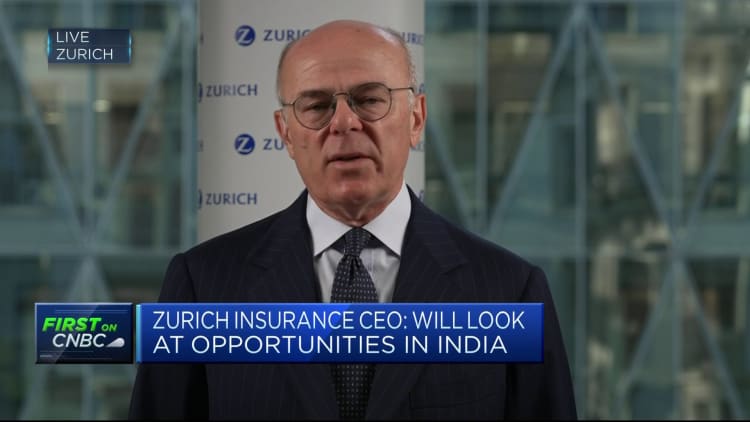
A pedestrian walks by an Allstate Insurance office on June 09, 2023 in San Francisco, California.
Justin Sullivan | Getty Images News | Getty Images
Allstate and Allianz are making a sizable bet on the digital transformation of the commercial insurance market with a $265 million strategic investment in Next Insurance, an insuretech startup focused on the small business market.
For Next, which serves over a half million customers and is nearing $1 billion in premium revenue, it’s the largest equity round in its history, eclipsing a previous round of $250 million. The deal is also the largest in the insuretech space this year, according to PitchBook.
“There’s a massive opportunity with 30 million-plus small business owners in the U.S.,” said Guy Goldstein, CEO and co-founder of Next Insurance. He also pointed to a growing class of younger, in business for less than 15 years, and new entrepreneurs that want access to digital processes.
Next Insurance ranked No. 37 on the 2022 CNBC Disruptor 50 list.
Unlike personal auto and home insurance markets, where digital transformation of policy sales and claims have migrated online to a significant extent, the commercial insurance market remains fragmented and in many cases still reliant on manual processes.
According to a July 2022 report from investment banking and brokerage firm William Blair, a “new guard” in property and casualty insurance could reach upward of 50% of total insurance value by 2032, representing $350 billion that is “up for grabs” over the next decade.
E-commerce sales as a percentage of total sales in the commercial market are growing, according to William Blair’s data, at a compound annual rate of roughly 10%, and even higher during the Covid lockdowns. That has created a challenge for traditional insurers, which have tended to lag on digital implementation, it said, and where customer pressure on legacy insurers to adapt to the changing environment has been increasing.
The commercial market is a much more complex one to transform digitally compared to personal lines where a generic application can be completed easily online. “The product is extremely complicated, unlike auto or home,” Goldstein said. “In commercial, there are all kinds of liabilities and compensation factors.”
The small business market specifically is also one where owners often lack insurance expertise and internal finance staff to handle the policy decisions. “It’s a $140 billion market but it is extremely fragmented,” Goldstein said. “No Geico or Progressive.”
NEXT co-founders (left to right): Alon Huri, CEO Guy Goldstein, CTO Nissim Tapiro.
Next Insurance
Next’s online platform offers coverage including general liability, commercial property, and workers’ compensation. Liabilities covered in the small business market cover a wide range of risks, from workers on job sites getting injured or breaking property to business equipment.
Next, which says it is the largest provider of “embedded” digital commercial insurance products in the U.S., sells through partnerships with Intuit, benefits provider Gusto, captive insurance agents of larger providers and independent insurance agencies.
Goldstein said the deal with two of the biggest insurers in the world is as important for the strategic aims to transform the business digitally as it is for the size of the capital being invested.
With Allstate, Next will be developing commercial auto insurance products, a market which in the U.S. remains highly manual today.
“Whether a pickup truck or fleet of cars for pizza delivery, today in the U.S. you can’t go online and buy it like a personal line of auto,” Goldstein said.
Next previously had its own commercial auto business but shut it down for financial reasons.
Strategic investors are playing a more prominent role in the insuretech funding market after the startup crash of 2022 and the retreat by many venture capitalists with unprofitable fintechs bleeding cash and those that had gone public seeing sharp declines in value.
The category of pre-profitability public insuretechs like Root Insurance and Lemonade declined by 78% in 2022 and this year is down 15%, according to William Blair.
“We have to become profitable, we’re not there yet,” Goldstein said. “There were a lot of companies that put a lot of money into fintechs and they are not all good,” he added.
Robert Le, an insuretech analyst at PitchBook, said more strategic investors are showing up in recent deals. Corporate VC arms such as those within insurance giants are less price sensitive than VCs since they can attract value outside of a financial return, but also may see the current market as one in which to double down on buying opportunities where they see a strategic rationale.
Overall, insuretech funding is anticipated to be on pace with the year-ago level in Q3, with approximately $1.6 billion in deals, roughly half of its peak hit in the second quarter of 2021. Insuretech deals have been above $1 billion through the first three quarters of 2023. “It is ikely that investments have bottomed out in terms of how much lower they can go,” Le said.
But exits have been minimal through the public markets as investors still feel the burn of the recent IPOs and SPACs from the insurance sector.
A focus on strategic fits makes sense for now, Le said, in both reinsurance where having that backstop is key for market confidence and to gain access to new markets where insuretech is gaining ground.
Even though the public companies have suffered, “the opportunity is still big across the entire value chain,” Le said. “There are still significant inefficiencies. The industry is slow to innovate and it’s a pretty unique market.”
But in the short-term, he said, it will continue to be a challenging environment.
“We are focused on execution,” Goldstein said. “Many companies went public too early. I know it was a good time to go public, but the company needs to be ready,” he said.
Next will need to get closer to profitability, and predictability in growth and profit & loss metrics, before it decides on its next steps related to a potential exit, he said.